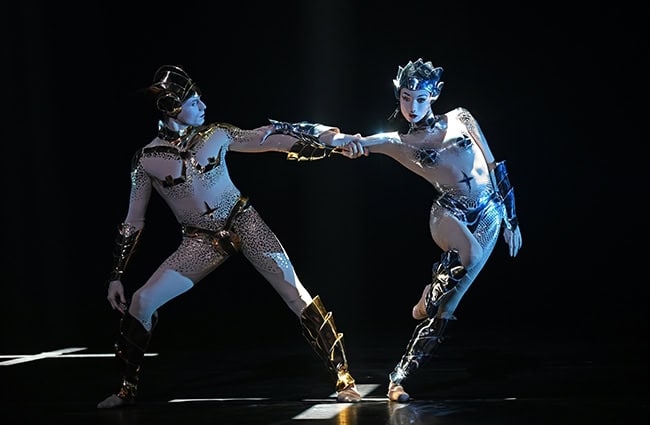MuzArts Triple Bill of Clug, Cherkaoui and McGregor at The London Coliseum
Posted: December 23rd, 2019 | Author: Nicholas Minns & Caterina Albano | Filed under: Performance | Tags: Anastasia Stashkevich, Denis Matvienko, Edward Clug, Edward Watson, Holly Herndon, Hussein Chalayan, Katja Khaniukova, Leo Kulaš, Lucy Carter, Manfred Thierry Mugler, MuzArts, Nils Frahm, Olga Smirnova, Radiohead, Sidi Larbi Cherkaoui, Tomaž Premzl, Vaslav Nijinsky, Vyacheslav Lopatin, Wayne McGregor | Comments Off on MuzArts Triple Bill of Clug, Cherkaoui and McGregor at The London ColiseumMuzArts Triple Bill of Edward Clug, Sidi Larbi Cherkaoui and Wayne McGregor, The London Coliseum, December 7

The second London program from MuzArts is a triple bill comprising the choreographic work of Edward Clug, Sidi Larbi Cherkaoui and Wayne McGregor. In terms of dancers it’s a mix and match program with principals of the Bolshoi and Mariinsky working alongside first soloist Katja Khaniukova from English National Ballet, principal Edward Watson of the Royal Ballet and five dancers from SNG Maribor Ballet.
Radio & Juliet is Clug’s reimagining of Shakespeare’s tale in choreography and film to a selection of early songs from Radiohead; the play on words in the title points to the emotional core of the work and indicates its primary perspective. In this version, Juliet has not taken her own life but is slowly piecing together the emotional turmoil of the recent tragic events. Using three sections of film to contextualise and weave the narrative together, Clug begins with a hand-held sequence — accompanied appropriately by Radiohead’s Motion Picture Soundtrack — that enters a palatial apartment to find Juliet in a black bodice lying alone in a rumpled bed. There’s a flashback of an angry argument, perhaps with her father, before she sits in front of the window to contemplate. Her thoughts find form in Clug’s fast-paced and clinically precise stage choreography. A procession of six men dressed in dark suits with jackets open over bare chests introduces the cast of characters without identifying them, though Mariinsky principal Denis Matvienko’s muscular presence and technical proficiency signal him out as Romeo while the identities of the others are suggested through their subsequent actions. Khaniukova takes her place in this macho environment as Juliet herself might have done, her stage character portrayed in controlled, physical sensuality and in her headstrong determination to follow her heart. This is where Radiohead’s playlist gets under the skin of the entire production; Clug’s choreography, Tomaž Premzl’s lighting and Leo Kulaš’ costumes all combine to visualise the visceral forces of jealousy and hatred that tear relationships apart, while the music provides an emotional anchor inside Juliet’s head that holds them together. Towards the end the camera revisits Juliet’s apartment; still in her black corset she is lying in her bath with eyes closed, remembering Romeo’s final moments that she plays out briefly on stage. The camera remains for a last wistful look around the empty rooms before leaving by the way it had entered.
Sidi Larbi Cherkaoui’s Faun features Bolshoi Ballet principals Anastasia Stashkevich and Vyacheslav Lopatin in this tale of sexual arousal that Vaslav Nijinsky first choreographed in 1912 to Claude Debussy’s score, Prélude à l’après-midi d’un faune, after the poem by Stéphane Mallarmé. Cherkaoui uses the same score with additional musical inserts by Nitin Sawhney. As Lopatin’s appearance in the Zakharova program showed, he has a fine classical technique but in Faun he undresses the classicism for a more pliable, plastic form, providing a poignant reminder of Nijinsky’s own chameleon propensity. In the opening solo Lopatin’s body exudes the lecherous and lascivious passions of the faun in the narcissistic, introverted enjoyment of movement and space. When Stashkevich arrives on stage, as imagined in Hussein Chalayan’s pastoral tunic, she looks more chaste but the subsequent rapture of the choreographic language blends both bodies in a shared jouissance.
Wayne McGregor claims responsibility for choreography and direction in the world première of McGregor + Mugler, while Manfred Thierry Mugler takes on the art direction and costume design. It is the latter that predominantly occupies our eyes while McGregor’s choreography — never strong in classical content or partnering — succeeds in making Edward Watson and the Bolshoi’s prima ballerina Olga Smirnova look as if they are performing a pastiche of an under-rehearsed pas de deux to tracks by Holly Herndon and Nils Frahm. While Watson is clearly not at his best, Smirnova is at the height of her career but she has trouble emerging from McGregor and Mugler’s framework. Mugler’s design of the flesh-like bodysuits, face masks, top knots and various reflective helmets, breast pieces, cod pieces, shin pads and amulets, effectively hides the dancers, and by making the masks so indistinguishable from their faces — certainly from a viewpoint halfway back in the stalls — we see no difference when they ritually exchange them. Perhaps that’s the point. The sophistication of Lucy Carter’s lighting is caught up in the pretension of its context, contributing to a spectacle in which the dancers are unwitting appendages to the hubris of its creators.
